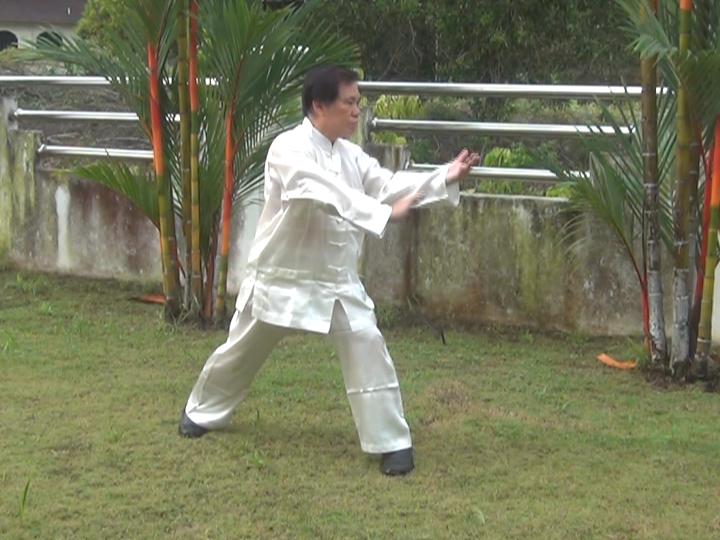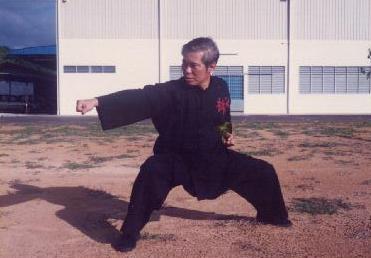TECHNIQUES, SKILLS AND KUNGFU SETS IN ZEN CULTIVATION

Grasping Sparrow's Tail in Yang Style Taijiquan
Question 8
What techniques, skills and kung-fu sets are notable for cultivating Zen in Shaolin Wahnam?
Chris
Answer
Our school is very special. All practice in our school is a training of the physical, energy mind. Hence, when we train kungfu, we also train chi kung and meditation. We do not need to include any chi kung exercise or separately practice any meditation because they are already incorporated in our kungfu training.
We have such elite advantages because of two special skills we train at the start and completion of every practice session. These two special skills are entering into a chi kung state of mind, or entering Zen or Tao, and enjoying an energy flow. When we enter into a chi kung state of mind, we practice meditation. When we enjoy an energy flow, we practice chi kung.
So every technique, skill and kungfu set in Shaolin Wahnam is suitable for cultivating Zen. Indeed, it is precisely because of this Zen cultivation in all our training, that we have unbelievable results in a very short time. We put into practice the saying that the highest chi kung and kungfu are of the mind.
Nevertheless, certain techniques, skills and kungfu sets are specially cost-effective for Zen cultivation.
Grasping Sparrow’s Tail is an excellent set of techniques for cultivating Zen. If it is performed correctly much internal force as well as mental clarity are generated. However, if it is not performed correct, i.e. with mind training, it degrades into some gentle physical exercise. This, unfortunately, applies to more that 80% of students who practice Grasping Sparrow’s Tail. Worse, as some of them do not even perform the external form correctly, they develop adverse effects like knee injuries and back pains.
It is illuminating to contrast Grasping Sparrow’s Tail, which is found in the fundamentals of Taijiquan, like in the set, “Cloud Hands Grasp Sparrow”, with a fundamental sequence in Lohan Asks the Way, a fundamental set in Shaolin Kungfu. Depending on one’s perspective and skill, Lohan Asks the Way is not effective for cultivating Zen or most effective for cultivating Zen!
A practitioner may not be in a state of Zen, i.e. a meditative state, yet he may still perform Lohan Asks the Way quite well. This is because Lohan Asks the Way is a set at a physical level. Even without internal force and a Zen state of mind, practitioners can still improve their combat or daily life. Practicing the set, amongst other benefits, enables practitioners to increase their strength, stamina, endurance and agility.
These benefits are not available to Grasping Sparrow’s Tail if the techniques are performed as gentle exercise instead of internal art. At its best it is a dance, good for demonstration as well as making practitioners graceful. But if it is performed as an internal art, its benefits are more than those from Lohan Asks the Way as it is normally practiced. Besides an increase in strength, stamina, endurance and agility, as in Lohan Asks the Way, Grasping Sparrow’s Tail generate internal force and mental clarity, which will produce better results no matter what the practitioners do!
In other words, when the two sets of techniques are practiced in their normal way, Grasping Sparrow’s Tail has more benefits than Lohan Asks the Way. But if they are practiced poorly, though not wrong as harmful side effects do not occur, Lohan Asks the Way has more benefits.
But if Lohan Asks the Way is performed superbly as an internal art, its benefits surpass those of Grasping Sparrow’s Tail. Students in Shaolin Wahnam have a change to perform Lohan Asks the Way superbly because their kungfu training, which is physical to other people, become chi kung and meditation to the initiated.
Skills that are most conducive to Zen cultivation are generating energy flow and generating internal force. Even without specially practicing Zen methods, Zen cultivation is present in these two skills. Without a Zen mind, it is not possible to generate an energy flow and to generate internal force.
It is no surprise, that our students, despite not having undergone formal Zen training, have Zen benefits, like being relaxed and joyful, and having a one-pointed mind. These benefits are derived when they generate an energy flow and generate internal force, which are hallmark of our arts.
Of the two skills, generating internal force is of a higher level. In generating an energy flow, the Zen mind of a practitioner is passive. He does not tense his muscles, and he does not think of any thoughts. As a result his energy will flow. He just lets go and follow the energy flow.
In generating internal force, the Zen mind of a practitioner is active. First, he needs to be passive to let his energy flow. Then he actively uses his mind to increase the verosity of the energy flow to generate flowing force. Or he uses his mind to focus his energy to have consolidated force.
The two kungfu sets that span the range of internal force training where Zen cultivation is innately involved are 108-Pattern Yang Style Taijiqusn on one end and Iron Wire on the other. The 108-Pattern Yang Style Taijiquan Set is 100% generating flowing force, whereas the Iron Wire Set is 100% consolidating force.
Zen cultivation is involved in both generating flowing force and building consolidated force, though the nature and function of the cultivation may be different. In both case, mental clarity and mental focus are required. In mathematical terms, in flowing force the mind is reduced to zero, and in consolidated force the mind is reduced to one.
When the mind is trained to be clear and to be one-pointed in internal force training, the skills of mental clarity and mental focus can be applied in any activities in our daily life.
As a rough guide the proportion between flow and consolidating, or between mental clarity and mental focus in the process of internal force training of the kungfu sets below is as follows:
- Yang Style Set – 100 % - 0%
- San Zhan – 90% - 10%
- Baguazhang – 80% - 20%
- Flower Set – 70% - 30%
- Dragon Strength – 60% - 40%
- Wudang Taijiquan – 50% - 50%
- Flowing Water Floating Clouds – 40% - 60%
- Siu Lin Tou – 30% -70@
- Xingyiquan - .20% - 80%
- Triple Stretch – 10% - 90%
- Iron Wire – 0% - 100%
This is a rough scale for orthodox training of the sets. But we in Shaolin Wahnam are elite; we can modify the proportion to suit our purpose, or fun. We may, for example, employ 100% consolidating force in 108-Pattern Yang Style Taijiquan Set, or 100% flowing force in Iron Wire Set. In the Special Wuzuquan Course in Penang in December 2012 course participants used techniques from the San Zhan Set for various force training skills, like in Flower Set, Triple Stretch and Iron Wire.
Being the most versatile as well as tremendously powerful, the Dragon Strength Set is the best for experiencing various force training methods found in the different sets. Although the proportion between flow and consolidating in Dragon Strength is 60-40, a skillful practitioner may use the set for 100% of flow as in Yang Style Taijiquan, or 100% of consolidation as in Iron Wire, or any set in between.

"Precious Duck Swims through Lotus" in Lohan Asks the Way
The above is reproduced from the thread Zen Intensive in Hawaii Q&A in the Shaolin Wahnam Discussion Forum
LINKS
